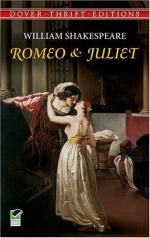|
This section contains 10,079 words (approx. 34 pages at 300 words per page) |

|
SOURCE: Brown, Carolyn E. “Juliet's Taming of Romeo.” Studies in English Literature: 1500-1900 36, no. 2 (Spring 1996): 333-55.
In the essay that follows, Brown analyzes the characterization of Juliet, stressing the young woman's depth of character and examining her search for selfhood.
Shakespeare's Juliet has received divergent critical appraisals. Early criticism, in particular, of Romeo and Juliet largely overlooks Juliet, viewing the play as being primarily about Romeo and treating Juliet as a subsidiary, underdeveloped character. When such criticism explores Juliet, it is often influenced by her young age of fourteen, reading her as little more than a child—naive, immature, inexperienced, obedient to her parents' wishes, and uncomplicated. E. C. Pettet, for example, characterizes Juliet as a “spontaneous, passionate child of nature, whose speech and heart are always one.”1 But as criticism, especially feminist in orientation, begins to recognize the depth of Shakespeare's female characters, Juliet is receiving more...
|
This section contains 10,079 words (approx. 34 pages at 300 words per page) |

|


